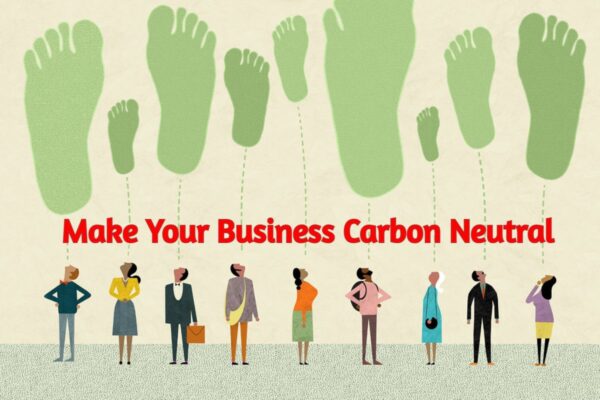Top 5 Companies That Have Pledged To Go Carbon Neutral

Top 5 Companies That Have Pledged To Go Carbon Neutral
To tackle climate change, a number of well-known companies have made the commitment to become carbon neutral, stating that the carbon dioxide produced by their operations will be balanced out by emissions from other sources. It’s not just for eco-friendly enterprises.
Numerous tech firms are becoming carbon neutral. All of these digital giants have vowed to help find a solution to this issue by reducing their carbon emissions.
At the CoP26 in Glasgow, when Prime Minister Narendra Modi announced a five-step plan to achieve the NDCs goals, the Indian government amended these objectives.
- The first of these five goals is to reach 500 GW of non-fossil energy capacity by 2030.
- The second is to meet 50% of the nation’s energy needs through renewable energy sources by 2030.
- The third is to reduce projected carbon emissions by 1 billion tonnes by 2030.
- The fourth is to reduce the economy’s carbon intensity by less than 45% by 2030.
- The fifth goal is for India to achieve net-zero emissions by 2070.
Environmental scientists view India’s NDCs as “serious climate action” and feel that the country is taking more steps than other nations to cut emissions and reach net-zero targets by 2070. According to revised NDCs, experts predict that India will use 9% of the IPCC’s 400Gt (gigatonnes) remaining carbon budget for limiting global warming to 1.5 degrees Celsius by 2030, 8.4% of global emissions in this decade, and 4.2 percent of global emissions from 1870 to 2030.

India will need to take more steps to cut emissions from the energy-intensive industrial sector and the transport sector if it wants to reduce carbon intensity by 45 percent. It will be necessary to significantly reduce the use of coal and crude oil across all industries and switch to more effective and clean alternatives like solar and hydrogen. Putting in place sufficient measures to offset rising greenhouse gas emissions from other industries will be just as crucial.
For India to reach its challenging net-zero goal, a number of concerns will still need to be taken seriously, such as the cost of more environmentally friendly and energy-efficient technologies, which is always a deterrent to their widespread adoption. Other considerations include the geopolitical and socioeconomic elements involved in the switch from coal to renewable energy sources, as well as the trade-offs related to the adoption of alternative energy sources and technologies.
To eventually achieve clean and affordable growth for all, India must also expand on effective climate governance, robust institutional and public participation, and coordination among various sectors.
What is Carbon Neutrality?
A balance between carbon emissions and carbon absorption from the atmosphere in carbon sinks is referred to as carbon neutrality. Carbon dioxide is taken out of the air and stored through carbon sequestration. All global greenhouse gas emissions must be balanced out by carbon sequestration in order to achieve net-zero emissions.
Companies, processes, and products become carbon neutral when they assess their carbon emissions and make up for them through carbon offsetting programs. A complete climate policy must include carbon offsets in addition to avoidance and reduction.
As a result of the uniform distribution of greenhouse gases like carbon dioxide throughout the atmosphere, it may be assumed that global greenhouse gas concentrations are rather constant. As a result, neither the global concentration of greenhouse gases nor the greenhouse gas effect is affected by where emissions are produced or avoided in the world.
As a result, emissions that cannot be reduced locally can be made up for through global carbon offset programs. This can be achieved, for instance, by the preservation of forests, reforestation, or the expansion of renewable energy sources.
What does it mean to be carbon neutral?

Companies all across the world have made commitments to becoming carbon neutral, but how do they achieve it? Companies are recommended to approach their problem using a carbon accounting system. First, utilize our user-friendly Carbon Management programs to determine your company’s carbon footprint.
Once you’ve calculated your organization’s overall carbon footprint, you’ll know more about how much you need to offset. Then, you can reduce carbon emissions by analyzing the worst carbon indicators—where your organization emits the most—and take appropriate action. Balance out what’s left, last but not least.
Since achieving zero carbon emissions is challenging, offsetting is a realistic way to attain carbon neutrality. By reducing your carbon footprint, you are making a strong statement to your neighborhood and laying the foundation for a future that is more sustainable
Communities most at risk from the consequences of climate change will receive low-carbon technologies thanks to the money collected through lowering their carbon footprint. However, you must make sure that the offset initiative is transparent and that local communities are involved.
Carbon neutral does not mean carbon-free
Despite being frequently used interchangeably, the terms “carbon-free” and “carbon neutral” refer to different aspects of climate action. Products, services, and businesses that are carbon-free do not produce any carbon emissions during production, delivery, or operation. This must apply to every step of the supply chain, including logistics, packaging, and all raw materials. In reality, there aren’t any examples of carbon-free products currently.
On the other hand, any business and any product can be carbon neutral because there are current criteria for calculating their emissions and approved carbon offset projects that businesses can fund to make up for the calculated emissions.
What distinguishes Carbon Neutrality from Net-Zero?
As our knowledge of the climate problem grows and we become more aware of the devastation that will result for us, the environment, business, industry, and the economy, so does our desire to decrease carbon while also being perceived to do so.
“Carbon-neutral” and “net-zero carbon” are two words that are frequently used and appear to be interchangeable. The two, however, are not the same. Net-zero carbon means no carbon was emitted at all, therefore no carbon needs to be caught or offset. Carbon-neutral refers to balancing out the overall quantity of carbon emissions. Using just solar energy and no fossil fuels, for instance, a business facility can claim to be “zero carbon.”
However, it is important to define net-zero carbon or emissions when using the term “net-zero.” The balance between greenhouse gas emissions (GHG) created and GHG emissions removed from the atmosphere is what is meant by net-zero emissions, on the other hand.
Even though the scientific idea is frequently used to describe nations like the US and China, it can equally be used for organizations. In other words, net-zero refers to the period when human activity ceases to increase the amount of climate-warming gases in the atmosphere.
5 ways for making your business carbon neutral
Globally recognized brands and businesses have made the commitment to becoming carbon neutral in support of the battle against climate change. A few firms that have committed to being carbon neutral by 2030, 2040, and 2050 are Unilever, Amazon, and Toyota. No of the type or size of business, every organization must aim toward carbon neutrality since time is running out and global warming is intensifying.
The method and timeframe for becoming carbon neutral will vary depending on the type and size of the firm. Here are some steps businesses may take to become carbon neutral and save our future.

Measure! The key to change is data:
Knowing where you are currently and how far you still have to go to reach carbon neutrality is the most crucial step. You will achieve your objectives much more quickly than you might anticipate if you are aware of the various direct and indirect sources of carbon emission and regularly report your progress. It is rather straightforward for businesses that don’t produce tangible goods because it usually just involves office space, energy, travel, and related expenses.
Carbon emissions for businesses that produce tangible goods are caused by the operation of machinery, the consumption of materials, and several operations-related activities.
Efficiencies can cover their costs:
One of the most effective techniques for lowering carbon footprint is efficiency improvement. This entails actions like switching from incandescent to LED lighting, scheduling and managing better manufacturing shifts, relocating personnel to a closer location, revamping products and packaging to use less material, etc. There are instances of businesses that have used straightforward yet efficient efficiency improvement techniques to cut their carbon emissions by as much as 40%.
Find more sustainable options:
Find strategies to use sustainable sources for your transportation, energy, and electricity. Installing solar panels is an excellent alternative and will pay for itself in the short to medium term if the facilities are under your direct control. Additionally, to reduce your carbon footprint, seek materials, goods, and resources at the facilities that you buy for both direct and indirect use.
Include purchasing procedures and methods that have an emphasis on acquiring goods and commodities with low carbon footprints and high renewable content.
Consider using circular design principles:
The circular design emphasizes the use of recycled and renewable materials, minimizes waste, and promotes resource regeneration. Include them in the goods and services you provide to your clients. For instance, switching from single-use, throwaway items and packaging to reusable, circular products and services would undoubtedly reduce both your company’s and the community’s carbon footprint.
Consider taking advantage of modern shared services and technology:
Most of us enjoy traveling so that we may meet and greet people in person. While doing so has a positive social impact, it has a significant negative impact on the environment because of the carbon emissions caused by travel. When possible, traveling in shared or public transportation, virtual meetings, and public transportation should be used over solo travel. Find resources that may be shared, such as office space, furniture, and computer equipment, to further help reduce carbon footprint. Utilize automation tools to control how much energy your buildings and activities use.
Although going carbon-neutral may sound challenging, you don’t have to do it all at once. You may drive the change slowly by dividing the actions into smaller, more achievable chores. Eliminating corporate sources of CO2 and other greenhouse gas emissions is simply smart business because it is the most crucial and beneficial investment in our future.
Top 5 Companies That Pledged To Go Carbon Neutrality
The top five tech companies that have committed to carbon neutrality are shown below.
-
GOOGLE:

One of the IT firms that claim to have reached carbon neutrality in 2007 is Google. In 2017, Google became the first company to meet 100% of its yearly worldwide electricity needs with renewable energy by bringing about 6GW of new renewable energy online. This shows that the company purchases enough renewable energy to balance all of its electrical needs.
Google “matches” its energy demand since it is not yet economically feasible to run a company of Google’s size entirely on renewable energy sources. However, it has promised to decarbonize its electricity supply and run on carbon-free energy seven days a week, 24 hours a day, by 2030. According to the company’s 2021 sustainability report, Google Cloud and Google Workspace have zero operating greenhouse gas emissions.
-
APPLE:

By 2030, Apple’s entire business, manufacturing supply chain, and product life cycle would all be carbon neutral, the company announced in July 2020. According to the company, nearly 70 suppliers have committed to using only renewable energy in their manufacturing processes, which comes out to almost 8 gigawatts.
The company estimates that these agreements have the potential to reduce carbon dioxide emissions by almost 13.3 million metric tonnes. Additionally, Apple and the US-China Green Fund have partnered to invest $100 million in accelerated energy projects for its suppliers. Additionally, it uses more than 1GW of renewable energy for its internal operations. True, Apple is becoming carbon neutral, just like many other tech firms.
The company also said in March that the 2022 iPhone SE would be the first device to use its carbon-free aluminum smelting technology. The 16-inch MacBook Pro is likewise manufactured with low-carbon aluminum. Apple is also spending money on afforestation and other environmentally friendly methods to sequester carbon.
-
INTEL:

Another leading tech company, Intel, has made a commitment to becoming carbon neutral by 2040 as well as to increase energy efficiency and lessen the carbon impact of its platforms and products. The firm has also established a few interim objectives for 2030. The corporation aims to use solely renewable energy in all of its international operations by that time.
Intel will invest $300 million in energy-saving measures at its facilities, saving a total of 4 billion kilowatt-hours. Additionally, the company will build new buildings that meet the requirements of the US Green Building Council’s LEED program in Europe, Asia, and the United States. Additionally, it is working with its suppliers to identify areas for improvement, including increasing supplier emphasis on resource and chemical efficiency as well as energy-saving and the sourcing of renewable energy.
-
MICROSOFT:

Microsoft has exceeded the carbon-neutral target. Microsoft has committed to becoming carbon neutral by 2030. The company also claims that by 2025, it will have either directly or indirectly eliminated from the environment all of the carbon it has released into the atmosphere since its foundation in 1975.
To hasten the global development of carbon reduction, capture, and removal technologies, it has established a $1 billion climate innovation fund.
“While the world will need to accomplish net-zero, those who can afford to move sooner and go further should do so,” Microsoft President Brad Smith said in a news release.
-
IBM:

IBM stated in February that it would have zero net greenhouse gas emissions by 2030. In order to do this, the company will focus on reducing greenhouse gas emissions by utilizing renewable energy sources and carbon capture technologies to offset any leftover emissions.
The climate disaster is one of the most important issues of our time, according to IBM Chairman and CEO Arvind Krishna. “IBM’s commitment to being net-zero is a significant step forward that builds upon our long history of climate leadership and puts us years ahead of the Paris Climate Agreement’s targets,”
Thus,
Although achieving a net-zero energy system for India is a technically realistic objective, the changes required to do so are difficult. Even while the nation is moving quickly to implement the necessary transition, it will ultimately demand a change in the way people live, consume, and manage resources, notably energy resources, and invest intentional and ongoing efforts across all areas of human intervention.
edited and proofread by nikita sharma




